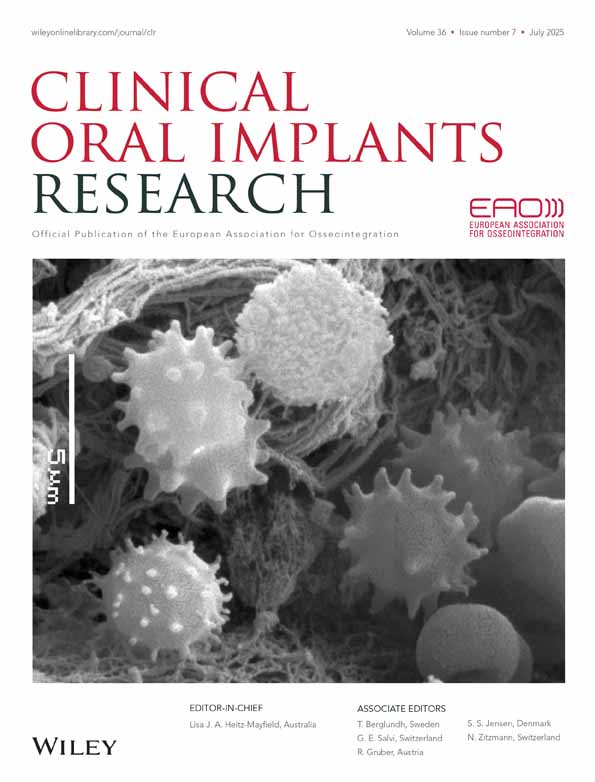The effects of fixed and removable implant-stabilised prostheses on posterior mandibular residual ridge resorption
Abstract
enAbstract: This study investigated the change over time in the area of the posterior mandibular residual ridge in patients wearing either i) mandibular overdentures stabilised by two implants (Brånemark System; Nobel Biocare, Göteborg, Sweden) connected by a bar, or ii) mandibular fixed cantilever prostheses stabilised on five or six implants. Proportional measurements were made in order to compare the area of the residual ridge with an area of bone uninfluenced by resorption. Measurements were made by digitising tracings of panoramic radiographs that were taken shortly after implant insertion and up to seven years later. With the use of overdentures, the posterior bone area index reduced by a mean of 1.1% per annum, while a mean bone area index increase of 1.6% per annum was demonstrated in association with fixed prostheses. A multiple linear regression model was fitted to predict the change in posterior area from type of prosthesis, gender, age, years of edentulism and initial height of the mandible. The model was only significant for initial height of mandible (P = 0.04) and type of prosthesis (P = 0.0001). In conclusion, patients rehabilitated with implant-stabilised mandibular overdentures demonstrated low rates of posterior mandibular residual ridge resorption, while patients rehabilitated with implant-stabilised mandibular fixed cantilever prostheses demonstrated bone apposition in the same area.
Résumé
frCette étude a analysé la variation dans le temps de la crête résiduelle de l'aire mandibulaire postérieure de patients portant soit des prothèses amovibles stabilisées par deux implants ad modum Brånemark® connectés par une barre, soit des prothèses fixées et stabilisées sur cinq ou six implants. La méthode s'est sevie des mesures proportionnelles comparant l'aire de la zone résiduelle avec une aire osseuse non-influencée par la résorption. Les mesures ont étéétablies en digitalisant les tracés sur des radiographies panoramiques qui abaient été prises peu detempts après l'insertion implantaire et jusqu'a sept années plus tard. Avec des prothèses amovibles, l'indice del'aire osseuse postérieur se réduisait de 1,1% en moyenne par ennée tandis que cet indice augmentait de 1,6% par année lorsqu'il était associéà la présence de prothèses fixées. Le modèle de régression linéaire multiple a été utilisé pour pronostiquer le changement dans la zone postérieure suivant le type de prothèse, le sexe, l'âge, les années pendant lesquelles ils étaient édentés et la hauteur initiale de la mandibule qui était significative pour la hauteur initiale de la mandibule (p=0,04) et le type de prothèse (p=0,0001) seulement. En conclusion, les patients traités avec des prothèses amovibles stabilisées sur implants présentaient de faibles taux de résorption de la mandibule postérieure tandis que ceux qui avaient été traités par une prothèse fixée jouissaient d'une apposition osseuse dans cette même zone.
Zusammenfassung
deDiese Studie untersuchte die Veränderungen der Kieferkämme im posterioren Unterkiefer üfer längere Zeit. Die Patienten trugen im Unterkiefer entweder Hybridprothesen, welche auf Zwei ?mplantaten mit einem STeg befestigt wurden, oder festsitzende Extensionsbrücken, welche auf fünf bis sechs ?mplantaten verankert waren. Es wurden proportionale Messungen durchgeführt, indem man die Region des Kieferkammes mit einer Knochenregion verglich, welche keiner Resorption ausgesetzt war. Die Messungen wurden auf digitalisierten Durchzeichnungen von Orthopantomogrammen durchgeführt. Dei Röntgenbilder wurden kurz nach der ?mplantation und bis zu sieben Jahre später aufgenommen.
Unter den Hybridprothesen reduzierte sich der Knochenregion-?ndex im Mitte um 1.1% pro Jahr, während bei den festsitzenden Rekonstruktionen eine Zunahme des mittleren Knochenregion-?ndex um 1.6% pro Jahr gezeigt werden konnte. Ein multiples lineares Regressionmodell wurde entworfen, um die Veränderungen im posterioren Bereich des Unterkiefers durch den Typ der Rekonstruktion, das Geschlecht, das Alter, die Anzahl Jahre der Zahnlosigkeit und die initiale Höhe des Unterkiefers vorherzusagen. Das Modell ergab nur fü die initale Höhe des Unterkiefers (p=0.04) und für den Typ der Rekonstruktion (p=0.0001) signifikante Voraussagewerte. Es kann die Schlussfolgerung gezogen werden, dass Patienten, welche mit auf ?mplantaten befestigten Hybridprothesen versorgt wurden, nur geringe Resorptionen in Bereich der posterioren Kieferkämme zeigten, während Patienten mit festsitzenden implantatgetragenen Extensionsbrücken in der derselben REgion eine Knochenapposition aufwiesen.
Resumen
esEste estudo investigó el cambio en el tiempo del área de la cresta residual de la mandíbula posterior en pacientes usando sobredentaduras mandibulares estabilizadas por dos implantes conectados por una barra o prótesis fijas mandibulares en extensión estabilizadas por cinco o seis implantes. El método usa mediciones proporcionales comparando el área de cresta residual con el área de hueso influido por la reabsorción. Las mediciones se realizan por digitalización de trazos de radiografias panorámicas tomadas al poco de la inserción de los implantes y hasta siete años mas tarde.
Bajo las sobredentaduras el índice de área del hueso posterior se redujo de media un 1.1% por año mientras que en las prótesis fijas se demostró un incremento del índice de área del hueso de 1.6% por año. Se fijó un modelo de regresión múltiple linear para predecir el cambio en el área posterior desde el tipo de prótesis, genero, edad, años edéntulo y altura inicial de la mandíbula, que fue significativa para altura inicial de la mandíbula (p=0.04) y tipo de prótesis (p=0.0001) solamente. En conclusión, los pacientes rehabilitados con sobredentaduras mandibulares estabilizadas por implantes demonstraron índices bajos de reabsorción de la cresta residual de la mandíbula posterior, pero los pacientes rehabilitados con prótesis fijas mandibulares en extensión estabilizadas por implantes demostraron aposición de hueson en el mismo área.




